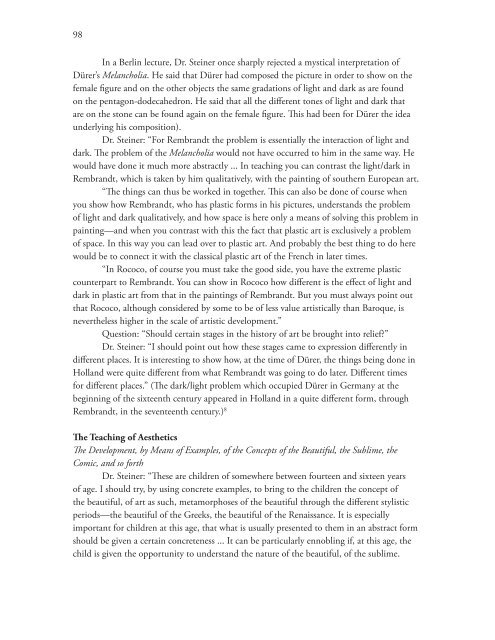Handwork and Handicrafts - Waldorf Research Institute
Handwork and Handicrafts - Waldorf Research Institute
Handwork and Handicrafts - Waldorf Research Institute
Create successful ePaper yourself
Turn your PDF publications into a flip-book with our unique Google optimized e-Paper software.
98<br />
In a Berlin lecture, Dr. Steiner once sharply rejected a mystical interpretation of<br />
Dürer’s Melancholia. He said that Dürer had composed the picture in order to show on the<br />
female figure <strong>and</strong> on the other objects the same gradations of light <strong>and</strong> dark as are found<br />
on the pentagon-dodecahedron. He said that all the different tones of light <strong>and</strong> dark that<br />
are on the stone can be found again on the female figure. This had been for Dürer the idea<br />
underlying his composition).<br />
Dr. Steiner: “For Rembr<strong>and</strong>t the problem is essentially the interaction of light <strong>and</strong><br />
dark. The problem of the Melancholia would not have occurred to him in the same way. He<br />
would have done it much more abstractly ... In teaching you can contrast the light/dark in<br />
Rembr<strong>and</strong>t, which is taken by him qualitatively, with the painting of southern European art.<br />
“The things can thus be worked in together. This can also be done of course when<br />
you show how Rembr<strong>and</strong>t, who has plastic forms in his pictures, underst<strong>and</strong>s the problem<br />
of light <strong>and</strong> dark qualitatively, <strong>and</strong> how space is here only a means of solving this problem in<br />
painting—<strong>and</strong> when you contrast with this the fact that plastic art is exclusively a problem<br />
of space. In this way you can lead over to plastic art. And probably the best thing to do here<br />
would be to connect it with the classical plastic art of the French in later times.<br />
“In Rococo, of course you must take the good side, you have the extreme plastic<br />
counterpart to Rembr<strong>and</strong>t. You can show in Rococo how different is the effect of light <strong>and</strong><br />
dark in plastic art from that in the paintings of Rembr<strong>and</strong>t. But you must always point out<br />
that Rococo, although considered by some to be of less value artistically than Baroque, is<br />
nevertheless higher in the scale of artistic development.”<br />
Question: “Should certain stages in the history of art be brought into relief?”<br />
Dr. Steiner: “I should point out how these stages came to expression differently in<br />
different places. It is interesting to show how, at the time of Dürer, the things being done in<br />
Holl<strong>and</strong> were quite different from what Rembr<strong>and</strong>t was going to do later. Different times<br />
for different places.” (The dark/light problem which occupied Dürer in Germany at the<br />
beginning of the sixteenth century appeared in Holl<strong>and</strong> in a quite different form, through<br />
Rembr<strong>and</strong>t, in the seventeenth century.) 8<br />
The Teaching of Aesthetics<br />
The Development, by Means of Examples, of the Concepts of the Beautiful, the Sublime, the<br />
Comic, <strong>and</strong> so forth<br />
Dr. Steiner: “These are children of somewhere between fourteen <strong>and</strong> sixteen years<br />
of age. I should try, by using concrete examples, to bring to the children the concept of<br />
the beautiful, of art as such, metamorphoses of the beautiful through the different stylistic<br />
periods—the beautiful of the Greeks, the beautiful of the Renaissance. It is especially<br />
important for children at this age, that what is usually presented to them in an abstract form<br />
should be given a certain concreteness ... It can be particularly ennobling if, at this age, the<br />
child is given the opportunity to underst<strong>and</strong> the nature of the beautiful, of the sublime.

















